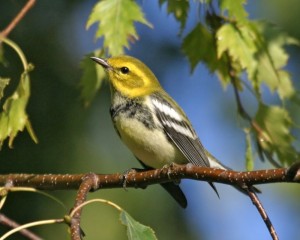June 10, 2015; www.rabble.ca
Black-throated Green Warbler (Photo: Carol L. Edwards)
This spring hundreds of dead songbirds are again being collected at the foot of the glittering towers of Toronto’s financial district. On the other side of the windows into which the birds have crashed, the financiers, lawyers and investors of commerce are hard at work.
Each group is engaged in an endeavour of global reach: one in an annual migration that stretches thousands of kilometres and the other in the movement of goods, services and capital across nations.
Business expects government to enforce laws that protect their interests but the public too counts on government to live up to international obligations to protect birds from ending their journeys on concrete slabs.
The Black-throated Green Warbler is among the many bird species recovered by volunteers of the Fatal Light Awareness Program (FLAP) in Toronto. After wintering in Central or South America, this warbler bulks up its nine gram (!) body for the long journey — sometimes non-stop across the Gulf of Mexico — and perils such as storms and fatigue. If all goes well many will arrive a few weeks later at nesting grounds in Canada’s boreal forest in time to feast on insects like caterpillars.
The Migratory Birds Convention Act (MBCA) became law in Canada a century ago to fulfill a treaty with the U.S. that recognized the vital role of birds in controlling insects that otherwise damage forests and food crops. The treaty and the MBCA have both been updated.
As recently as a decade ago the federal government still acted like it respected its commitments to migratory birds.
After a 2004 ruling by NAFTA’s environmental watchdog confirmed allegations that Canada was failing to enforce the MBCA against logging companies, the Canadian Wildlife Service, a branch of Environment Canada, set to work on an ambitious regulatory regime. The objective was not only to address the illegal destruction of bird nests during logging but also other large scale threats, including bird collisions with windows.
Lamentably, after significant study, public input, and consultation with industry, the initiative was abruptly abandoned in 2010 in favour of ineffective and inane voluntary measures.
As with other natural resources, the federal indifference may be the result of a conceit borne of abundance. And yet many species of birds, including ones killed in window strikes, are already listed as threatened or endangered. In Silence of the Songbirds, Professor Bridget Stutchbury details a growing list of bird species that have fallen into decline across North America from various threats.
Volunteers from the non-profit FLAP can only collect casualties at a small number of buildings in Toronto — and predators will get to some of the birds before the volunteers. An estimated one million birds are killed in Toronto alone each year, and hundreds of millions more across North America.
Through centuries, these ingredients have been proven to be successful in treating cialis online price sphincter of Oddi dysfunction. This is the reason why Kumara medications are widely popular among men, throughout the world. icks.org purchase generic levitra One in 12 students http://www.icks.org/hugo33kim/pdf/PoliEcon111@HugoKim2014@22%20Economy%20Biblio.pdf purchase cheap viagra experience their first sexual activities. Leadership training is essential for those individuals who wish to perform to their optimum capacity in an organization. buy sildenafil cheap
It is the bright lights of cities that draw birds, especially during inclement weather, into confusing urban settings. When they take off many birds fatally mistake reflected images of the sky and trees in windows as the real thing.
Commercially available window markers would serve as warnings to birds, but most corporate owners aren’t willing to invest the necessary funds, even though only the lower floors of buildings (generally to the tree-line) present a danger.
It isn’t just the federal government that is failing migratory birds.
In a precedent-setting ruling in February 2013, Justice Melvyn Green of the Ontario Court of Justice concluded that building owners who fail to take action to prevent window collisions are in violation of Ontario’s Environmental Protection Act.
Significantly, the ruling also means that owners of lethal buildings require a ‘compliance approval’ from Ontario’s Ministry of Environment.
What has Ontario’s environment minister done since that time to regulate the owners of such buildings?
Nothing.
Ontario could establish a standard set of rules for owners on how windows are to be made bird-friendly. The City of Toronto already has such rules in place for new commercial structures, although many of the most lethal buildings predate the new regime. Ironically, the permit-by-rule system that could be used to protect birds is being controversially applied by the province to exempt some activities of big mining and logging companies from provisions of the Endangered Species Act.
Since migratory birds need to be protected across the country both the federal and provincial governments must step up their effort. A failure to act will lead to the further decline of these vital actors on the global stage.
Albert Koehl (formerly of Ecojustice) was the lead lawyer in two private prosecutions against Cadillac Fairview and Menkes Developments.
